Sea vegetables, also known as seaweeds or marine algae, are edible plants that grow in or around saltwater environments such as oceans and seas. The history of human consumption of sea vegetables is as extensive as the oceans themselves. In other words, they have been consumed for centuries in many coastal regions around the world.
For example, Asian nations like Japan and China are famous for their algae-based broths and seaweed wrapped fish. Seaweeds have also been a staple in a number of cuisines in communities of Nordic seafarers, Polynesian islanders and Caribbean coastal dwellers.
Sea vegetables are not only delicious but also offer several health benefits. They are Low in fat and rich in fiber, minerals and vitamins.
In this article, let us talk about sea vegetables, looking into their history, their immense nutritional value, and their ability to elevate dishes to new heights of flavor and healthfulness.
List of Sea Vegetables/Weeds
- Nori
- Sea Kale
- Kelp
- Wakame
- Dulse
- Arame
- Hijiki
- Irish Moss
- Sea Lettuce
- Agar-agar
- Mozuku
- Kombu
- Sea Palm
- Ogonori
- Laver
- Bladderwrack
- Codium
- Sea Beans
Description And Facts
Nori
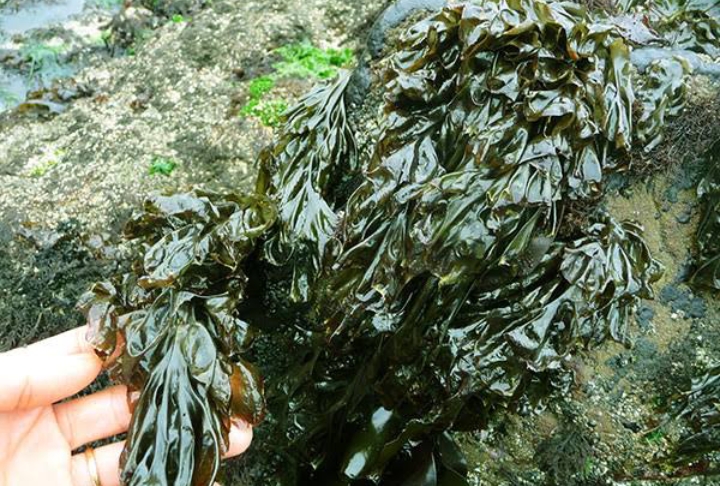
Nori is a dark green to purplish-black sea vegetable. It grows in shallow seawater along the coasts of Japan, China, Korea and other Asian countries. It commonly grows on nets or frames made of bamboo or other materials. It is actually the most popular sea weed/vegetable around the world.
In most cases, Nori is associated with sushi rolls (maki rolls) where it does the job of wrapping to hold the rice and various fillings. It can also be cut into thin strips or crumbled and used as a topping or garnish for salads, noodles, rice dishes and soups.
Many people describe the taste of nori as umami, that is, savory and slightly salty flavor. Some people even find it find to enjoy it in its raw form or toast it over a flame to enhance its crispness.
Sea Kale

Sea kale (Crambe maritima) is a perennial vegetable and grows wild along the coasts of mainland Europe and the British Isles. The plant has large, wavy leaves and thick, succulent stems. It can reach a height of up to 2 feet and forms a clump of rosettes.
Sea kale has a long history of culinary use, particularly in European countries such as England, France and the Netherlands. The young shoots, often referred to as “sea asparagus” or “sea truffles,”. These shoots can be prepared by steaming, boiling, stir-frying or blanching.
This kale pairs well with seafoods, citrus flavors, butter, olive oil, garlic and herbs such as thyme or dill. It can also be incorporated into recipes alongside fish or shellfish dishes to create a harmonious coastal-themed meal.
Kelp
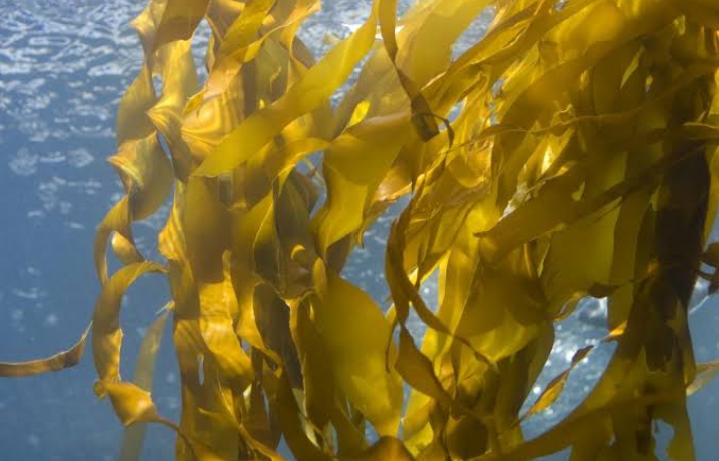
Kelp is a large brown seaweed that grows underwater or along rocky coastlines in cold waters around the world particularly in the northern hemisphere. It has long, ribbon-like fronds or leafy blades that can grow to impressive lengths. They grow in dense groupings much like a forest on land.
In East Asian cuisines such as Japanese, Korean and Chinese, Kelp is used as an ingredient in soups, stews, salads and side dishes. You can as well eat it raw, dry it into a powder and use it to impart a subtly sweet and briny flavor to dishes.
Wakame
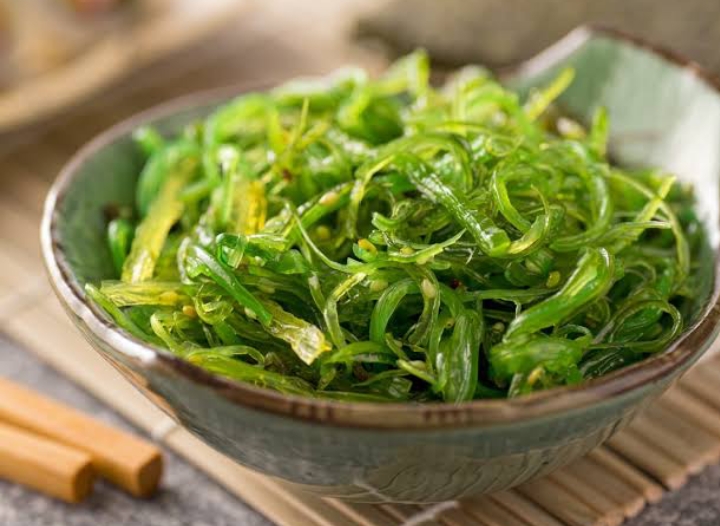
Wakame has dark green to brownish-green fronds that are thin and ribbon-like in shape. It grows in the shallow coastal waters of the Pacific Ocean, particularly in Japan, Korea and China. It is also the most cultivated sea vegetable in seaweed farms.
This sea weed is a popular ingredient in soups, particularly miso soup, where it adds a subtle umami flavor and some chewy texture. It is also used in salads, stir-fries, noodle dishes and sushi rolls.
Wakame is sold dried and needs to be rehydrated before use. It can be soaked in water for a few minutes until it softens and expands in size. Once rehydrated, it can be sliced or chopped into desired pieces and added to dishes.
Dulse

Dulse, also known as Palmaria palmata, is a seaweed or sea vegetable that grows along the Northern Atlantic coasts, particularly in regions like Ireland, Scotland and parts of North America. It has flat and translucent fronds that can be reddish-brown or deep purple in color. In the sea and oceans, it grows in intertidal zones, where it is exposed to both air and water during tidal changes.
Dulse has a salty and smoky flavor. It can be enjoyed both raw and cooked. In its raw form, dulse has a chewy texture and can be good for snacking or adding to salads and sandwiches. It can also be cooked in stews or even used as a seasoning or garnish.
Dulse is commonly sold dried and can be consumed as-is or rehydrated before use. To rehydrate, it can be soaked in water for a few minutes until it becomes soft and pliable.
Arame
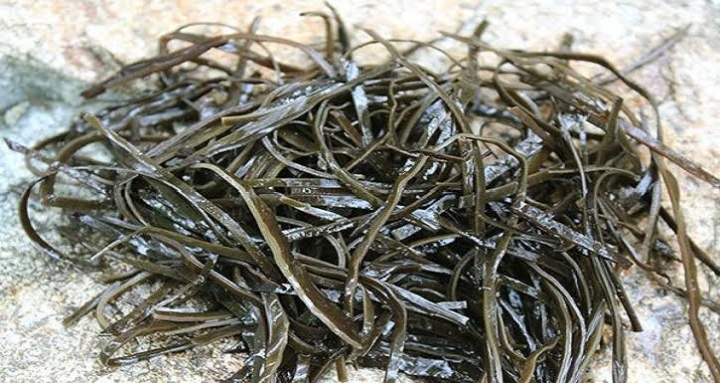
Arame seaweed is primarily found in the coastal waters of Japan and Korea. It grows in the intertidal zone, which is the area between the high and low tide lines. This seaweed has a long and wiry-like strands with a dark brown to black color. The strands are flexible but can become more pliable and softer when rehydrated.
Generally, it has a crispy texture and sweet flavor. Dried Arame can be eaten as is or rehydrated in water before use. It can be added to salads, sandwiches, pasta dishes or used as a seasoning on roasted vegetables or other seafood.
Hijiki
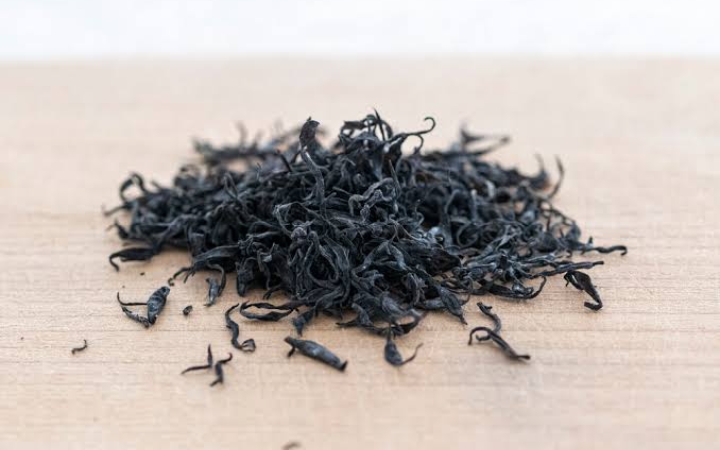
Hijiki, sometimes called hiziki, is a brown sea vegetable growing wild on rocky coastlines of East Asia. Hijiki has been a part of the Japanese culinary sphere and diet for centuries. Hijiki has been sold in United Kingdom natural products stores for 30 years and its culinary uses have been adopted in North America.
When dried, it forms small, wiry strands that expand and soften when rehydrated. Hijiki has an earthy flavor with hints of sweetness. The flavor intensifies when cooked.
In Japanese cuisine, hijiki is usually cooked with soy sauce, mirin (sweet rice wine) and other seasonings to make flavorful dishes. It pairs well with vegetables, tofu, seafood and mushrooms.
Irish Moss
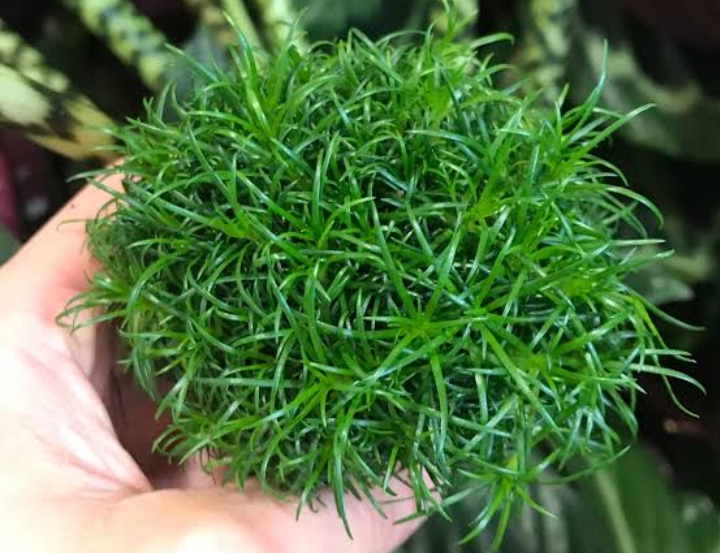
Irish Moss, also known as carrageen moss, is a seaweed that grows in plenty along the rocky shores of the Atlantic coasts of Ireland, Great Britain and North America. In its fresh condition, it is soft and cartilaginous in nature. Its color varies from a greenish-yellow, through red, to a dark purple or purplish-brown.
When softened in water it has a sea-like odor. This sea weed has been traditionally used as a thickening agent and a natural gelling agent in cooking. It contains carrageenan, a gelatinous substance that is extracted from the seaweed and used as a food additive.
Carrageenan is commonly used in the food industry for its thickening, stabilizing, and emulsifying properties. It is often found in products such as ice cream, yogurt, milk alternatives, sauces and processed meats.
Sea Lettuce
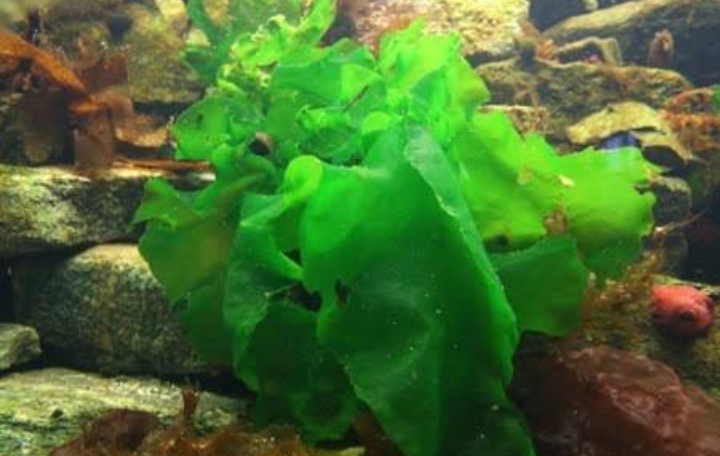
Sea lettuce, scientifically known as Ulva lactuca, is a common sea vegetable. It is commonly found in coastal waters, estuaries and intertidal zones. It usually thrives in areas with high nutrient levels. This sea weed can grow attached to rocks, shells or other substrates, as well as float freely in the water.
Sea lettuce is a common sea vegetable in Scandinavia, Great Britain, Ireland, China and Japan. It is usually used as a leafy green in salads or used as a wrap for vegetables, sushi or seafood. It also can be added to stews and broths, where it imparts a subtle sea-like flavor.
Some people use this sea weed as a garnish to add a greenish color to the dish. As a garnish, it is usually added towards the end of cooking to preserve its texture and color. Dried sea lettuce can also be ground into a powder and used as a seasoning or sprinkled on top of dishes for an umami kick.
Agar-agar
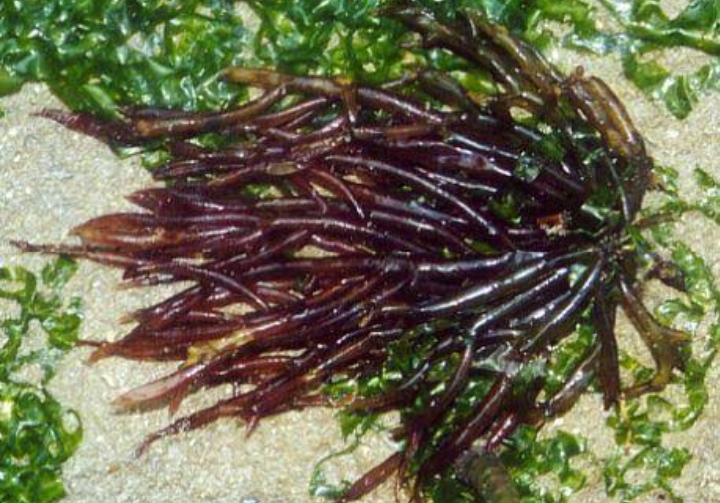
Agar-agar is commonly found in coastal regions of Japan, China, Korea and Southeast Asian countries. Its best quality is obtained from plants that grow in clean waters. It can be pale white or ivory to light yellow or greenish-yellow in color.
Agar-agar has been used in various culinary applications by Malay communities living on the coasts of the Riau Archipelago and Singapore in Southeast Asia for centuries.
When hydrated and heated, it softens and dissolves, forming a gel-like substance with a rubbery texture. This sea weed can be used as a gelling agent in desserts, such as puddings, custards, jellies and fruit gelées.
Mozuku

Mozuku grows in long branching threads that look like noodles. The threads can be dark brown or black in color. This seaweed is mainly found in the coastal waters of Okinawa, a group of islands located in the southernmost part of Japan. The seaweed grows attached to rocks or other hard surfaces in the ocean, usually at depths of 3 to 10 meters.
In Japanese cuisine, this seaweed is usually enjoyed in salads and soups. Also due to its refreshing taste it is often served cold during summer periods. Mozuku also combines well with ingredients like cucumber, sesame seeds and other vegetables.
Kombu
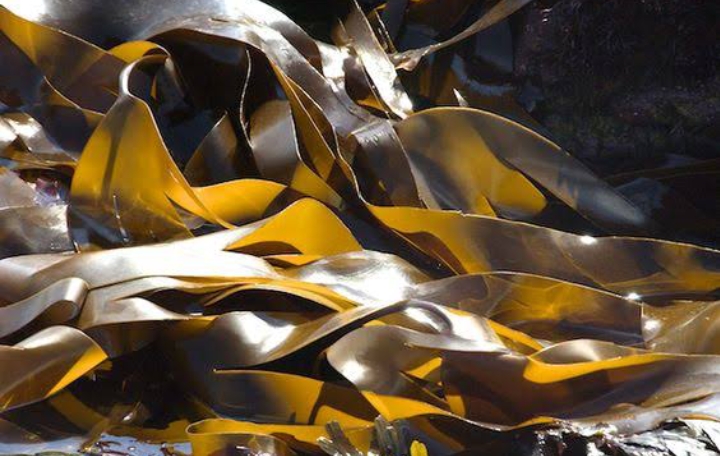
Kombu is commonly found in the waters around Japan, Korea, and other coastal regions. The color of kombu can be from dark green to brown. Its taste is somehow salty and savory. Some people usually describe it as umami.
Kombu features in the diets of many civilizations, including Chinese and Icelandic; however, the largest consumers of are the Japanese. Traditional Japanese dishes like dashi, a flavorful broth is made from Kombu. To make dashi, dried kombu is simmered in water to extract its essence.
Kombu can also be used as a natural flavor enhancer in dishes like as rice and noodles. kombu has some other interesting applications. It is sometimes used as a natural tenderizer for beans and legumes.
Sea palm
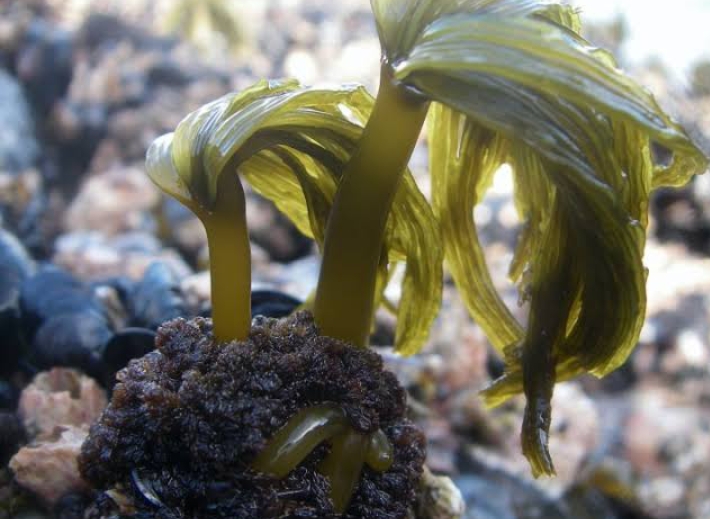
Sea palm, scientifically known as Postelsia palmaeformis is native to the rocky coastlines of the Pacific Ocean, particularly along the western coast of North America from California to Alaska.
Sea palm gets its name from its resemblance to a palm tree. It has a frond-like structure with a slender stipe that attaches to rocks in water. At the top of the stipe, the fronds spread out in a fan-like arrangement.
The blades (and less often, the stipes) are sometimes used in certain dishes, usually in California, particularly savory dishes. Some creative uses include incorporating it into sushi rolls, omelets and pasta dishes.
Ogonori

Ogonori, also known as sea moss or Gracilaria thrives mostly in saltwater. It can be found in parts of the world like Africa, Asia, Europe, and the Americas. It usually attaches itself to rocks, shells, or other submerged surfaces. It can as well grow in shallow waters, such as tidal pools, lagoons and rocky shores.
Common use of ogonori is in Japanese cuisine, where it is known as “nori-tsukudani.” In this preparation, it is simmered in a mixture of soy sauce, sugar, and other seasonings until it becomes tender. It is then served as a side dish or used as a topping for rice or noodles.
Ogonori is also common in Chinese and Korean cuisines. In Chinese cuisine, it is often added to hot pot dishes, stir-fried with vegetables or meat, or used as an ingredient in savory pancakes. In Korean cuisine, it is used in salads and side dishes.
Laver

Laver is found along the coastlines of many regions worldwide, including East Asia (Japan, China, and Korea), Europe (Ireland, Wales, and Scotland), Africa and North America. Laver has a thin, sheet-like structure with a reddish-purple or green color.
Laver has been a staple food in East Asian cuisines for centuries. In Japan, it is commonly used to wrap sushi and onigiri (rice balls). In Korea, it is called gim and is used in dishes like gimbap (rice rolls) and kimchi. It can also be used as an ingredient in soups and various snacks.
Bladderwrack

Bladderwrack, also known as Fucus vesiculosus is commonly found along the coastlines of the North Atlantic and Baltic Sea regions, including parts of Europe, North America and Asia. The name “bladderwrack” comes from the air-filled bladders or vesicles that are present along its body. This sea weed has a dark olive-brown or brownish-green color.
Bladderwrack can be dried and ground into a fine powder and used as a seasoning or condiment. It can also be pickled along with other vegetables or enjoyed on its own. It can also be infused in hot water to make herbal teas or added to blends with other herbs.
Codium

Codium, also known as green sea fingers or green sponge is prevalent in the North Atlantic Ocean, the Pacific Ocean, and the Mediterranean Sea. It grows in dense tufts forming branched structures.
The branches are cylindrical and can reach up to 30 centimeters or more. Codium can be used both raw and cooked. In its raw form, it can be placed on top of seafood dishes, pasta or risotto, just to enhance the overall appeal.
Sea beans

Sea beans, also known as samphire or sea asparagus can be found in coastal regions of many places around the world particularly in salt marshes and rocky shorelines.
Sea beans have long, slender and fleshy stems that look-like green beans or asparagus spears. The plants are harvested during their young and tender stage, when the stems are still pliable and less fibrous.
This seaweed usually has a crunch and salty flavor. It can be tossed with other fresh vegetables, greens and herbs, and dressed with a simple vinaigrette. They too can be served alongside grilled fish, seared scallops or steamed shellfish.